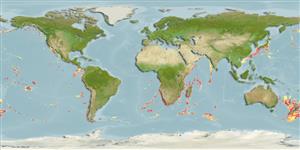Common names from other countries
Lớp phụ cá toàn đầu (Chimaera) (chimaeras) >
Chimaeriformes (Chimaeras) >
Rhinochimaeridae (Longnose chimaeras)
Etymology: Rhinochimaera: A chimaera with rhinos (Gr.), nose, referring to long, pointed proboscis of R. pacifica. (See ETYFish); africana: ana- (L.), belonging to: named for both its distribution around southern Africa and for the Sea Fisheries Research Institute research vessel Africana, from which holotype was collected. (See ETYFish).
Environment: milieu / climate zone / depth range / distribution range
Sinh thái học
Biển Tầng đáy biển sâu; Mức độ sâu 549 - 1450 m (Ref. 11228). Deep-water
Southeast Atlantic: southern Africa and Mozambique Channel. Pacific Ocean: Japan (off Hokkaido and northern Honshu) to the east China Sea, including Taiwan; Costa Rica and Peru.
Bộ gần gũi / Khối lượng (Trọng lượng) / Age
Maturity: Lm ? range ? - ? cm
Max length : 81.8 cm TL con đực/không giới tính; (Ref. 97389)
Short description
Khóa để định loại | Hình thái học | Sinh trắc học
This species is distinguished by the following characters: elongate body with an elongate, broad and paddle-shaped pointed snout extending anterior to head (SNL 47.7% HDL), tapering to a slender tail; the junction of supraorbital and infraorbital canals on ventral side of snout is closer to the tip of the snout than to the nasal canal; ONC/TIO is greater than 1.4 (ONC/TIO= 1.64); TIO/SWF is less than 1.5 (TIO/SWF= 1.47); TIO/LNC is less than 3.0 (TIO/LNC= 2.75); tooth-plates are nearly smooth; eyes are relatively small (EYL 6.4% BDL), distinctly behind level of mouth; the first and second dorsal fins are separated by a relatively long interdorsal space (IDS 23.6% BDL) and not connected by a web of skin; caudal-fin axis weakly raised with the fin asymmetrical, the epaxial caudal-fin lobe narrower than hypaxial lobe; dorsal caudal tubercles 25; caudal filament vestigial; coloration uniformly dark brown across entire body, except the oronasal region which is abruptly paler than the body (Ref. 97389).
Rare (Ref. 11228). Oviparous (Ref. 205). Eggs are encased in horny shells (Ref. 205).
Life cycle and mating behavior
Maturities | Sự tái sinh sản | Spawnings | Egg(s) | Fecundities | Ấu trùng
Heemstra, P.C., 1995. Additions and corrections for the 1995 impression. p. v-xv. In M.M. Smith and P.C. Heemstra (eds.) Revised Edition of Smiths' Sea Fishes. Springer-Verlag, Berlin. (Ref. 11228)
IUCN Red List Status (Ref. 130435)
CITES (Ref. 128078)
Not Evaluated
Threat to humans
Harmless
Human uses
Các công cụ
Special reports
Download XML
Các nguồn internet
Estimates based on models
Preferred temperature (Ref.
115969): 2.1 - 8.2, mean 5.5 (based on 195 cells).
Phylogenetic diversity index (Ref.
82804): PD
50 = 0.6289 [Uniqueness, from 0.5 = low to 2.0 = high].
Bayesian length-weight: a=0.00195 (0.00083 - 0.00458), b=3.15 (2.95 - 3.35), in cm Total Length, based on LWR estimates for this (Sub)family-body shape (Ref.
93245).
Mức dinh dưỡng (Ref.
69278): 3.8 ±0.5 se; based on size and trophs of closest relatives
Thích nghi nhanh (Ref.
120179): thấp, thời gian nhân đôi của chủng quần tối thiểu là 4.5 - 14 năm (Assuming Fec <100).
Fishing Vulnerability (Ref.
59153): Moderate to high vulnerability (53 of 100).
